
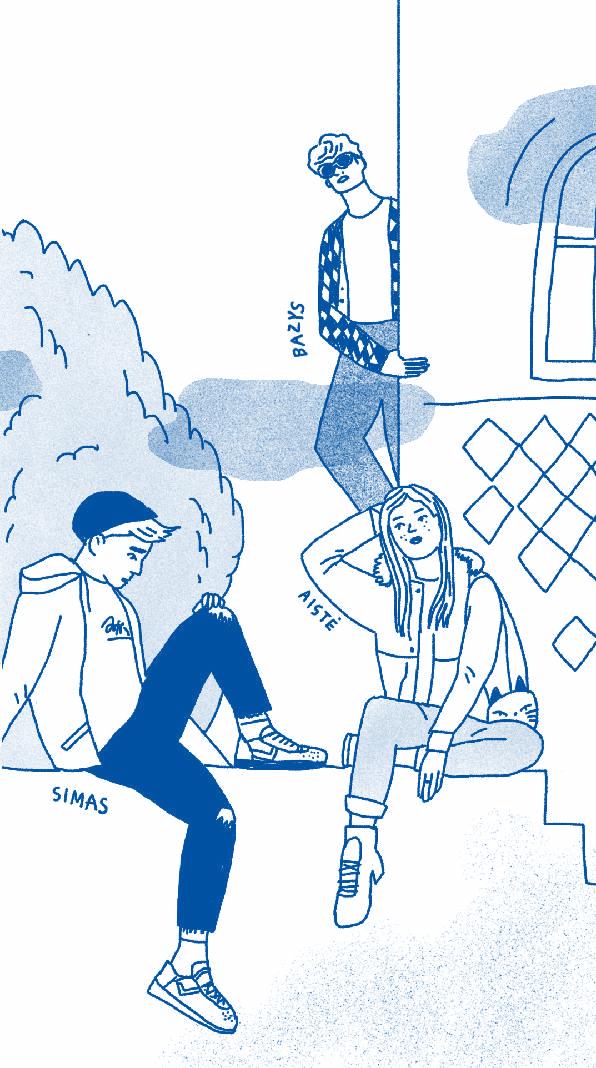





THE BERNARDINE CEMETERY
established this cemetery more than 200 years ago! I like it here...
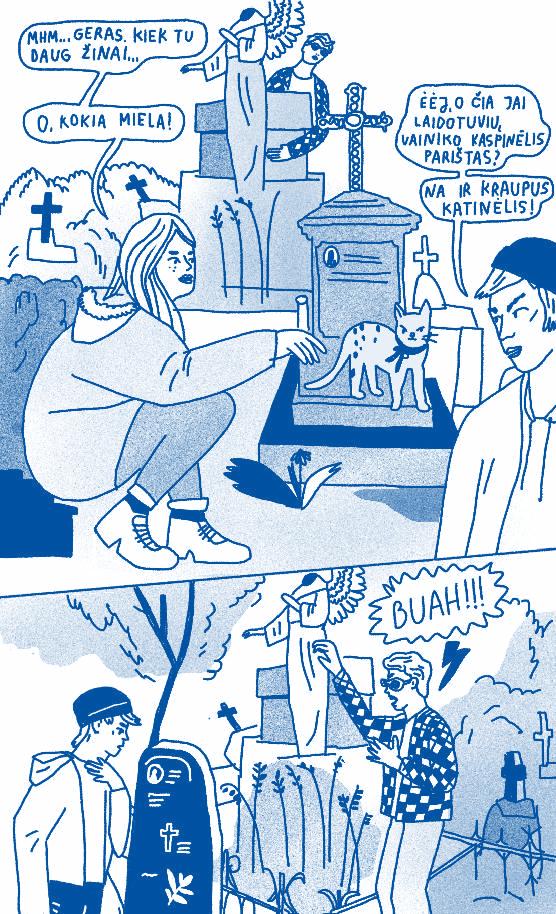

Hey! Are you a mad or something?! / Stop it!

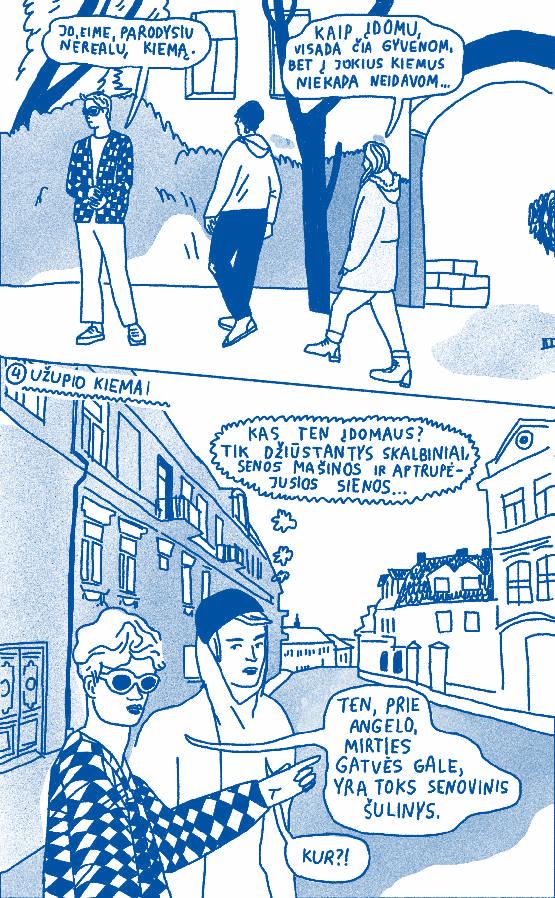



Want some rolls?






UŽUPIS CONSTITUTION


1. Let’s go in here!
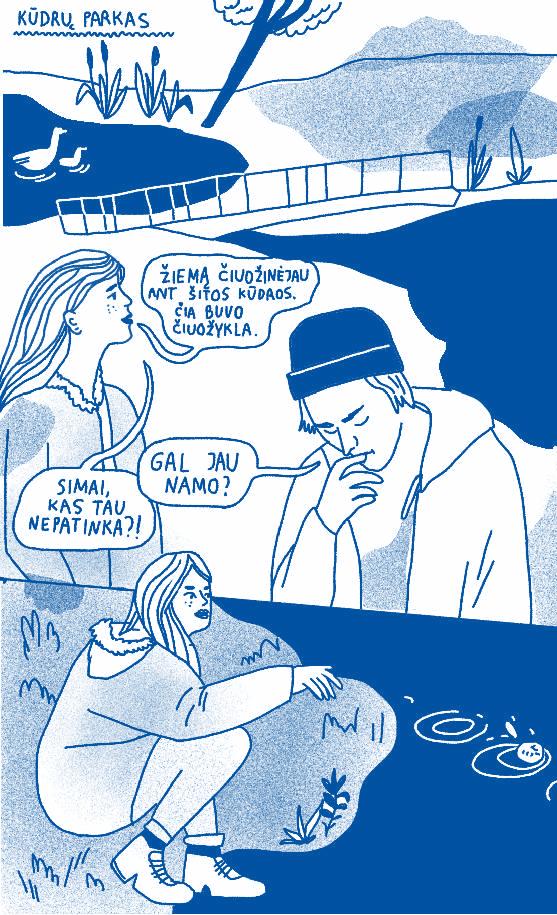

/
/
/ What
/
/

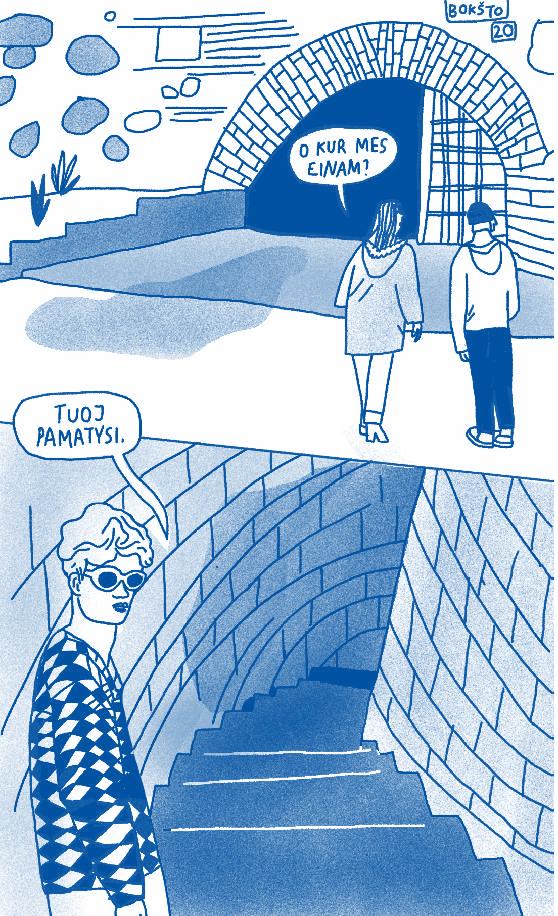

/ You don’t have to if you don’t want to.
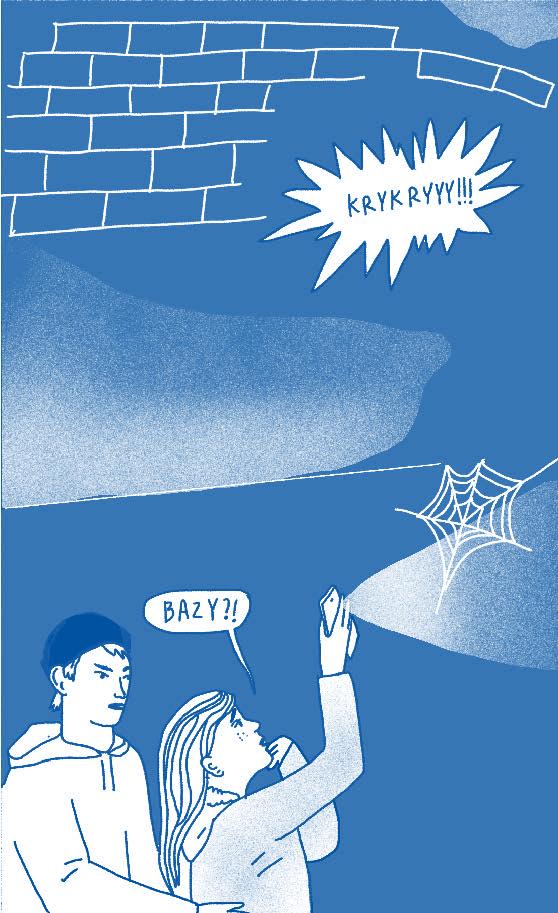





THE SUBAČIAUS STREET PANORAMIC PITCH
Simas, how come you knew what to do? / It’s nothing. I only remembered what I heard in our literature class. / You know, he looked suspicious to me from the very start. I didn’t really like that fellow. / Unbelievable..! I would have never thought that Bazys is such a monster. And lives in Užupis... / Mhm, next time have more trust in me. Home?


THE GATE OF DAWN
1. I wonder why it’s called the Gate of Dawn? / Hmm… I don’t know.
What are we gonna raid next time? / An ice peak perhaps? But right now, let’s go to café. It’s on me!


Kalnų parkas ir Bekešo kalnas → Užupis → Bernardinų kapinės → Užupio kiemai
→ Užupio Angelo skulptūra → Meno inkubatorius → Užupio respublika ir jos
Konstitucija → Tymo kvartalas → Vilniaus Bastėjos požemiai → Subačiaus gatvės
apžvalgos aikštelė → Aušros vartai

1. Kalnų parkas ir Bekešo kalnas. Savo tyrinėjimus pradėkite aukščiausioje miesto dalyje – Kalnų parke. Pirmasis iššūkis – surasti Bekešo kalną! Bekešo kalnas –šio komikso herojų, kurie mokosi Vilniaus Užupio gimnazijoje, mėgstama susitikimo vieta. Iš čia jie kiekvieną penktadienį eina patyrinėti miesto. Pirmiausia iš Antakalnio gatvės pusės per Kalnų parką eikite Vilnelės link, kol perėję nedidelį tiltą atsidursite prie Olandijos ambasados vartų. Nuo vartų sukite prie dešiniau esančio karvedžio Kasparo Bekešo obelisko. Jeigu lipsite iš Užupio gatvės, keliuką rasite už Užupio gimnazijos pastato. Kadaise ant šio kalno stovėjo mūrinis bokštas (arba paminklas) narsiam vengrų kilmės karvedžiui Kasparui Bekešui. Jis išpažino ne katalikų tikėjimą, todėl buvo palaidotas ant upės kranto. Ant drąsuolio paminklo buvo iškalti žodžiai: „Dangaus netrokštu, pragaro nebijau“. Gaila, bet XIX a. originalus paminklas kartu su K. Bekešo kapu nuvirto į Vilnelės upę. Išliko tik ąžuolinis obeliskas, rodantis kryptį į kalną. Beje, Vilnelė kadais garsėjo srauniais vandenimis, kurie paplaudavo smėlėtus krantus ir sukeldavo šalia esančių kalvų griūtis.
2. Užupis. Tyrinėsime Užupį – vieną seniausių Vilniaus rajonų, minimą nuo XV a. Užupis išsidėstęs į rytus nuo senamiesčio, dešiniajame Vilnelės krante. Priemiestį su miestu jungė daug tiltų. Senais laikais tai buvo vargingųjų priemiestis, kur šalia sraunios upės stovėjo daug malūnų, gyveno amatininkai (ypač daug audėjų), smulkūs valdininkai. Iki pat XX a. pabaigos tai buvo gana apleista ir pavojinga teritorija, į ją miestiečiai bijodavo net užsukti. Tačiau vėliau netikėtai Užupį pamėgo menininkai: čia jie galėjo įsigyti pigų būstą be patogumų ir mėgautis bohemiška atmosfera. Netrukus rajono menininkai susibūrė į bendraminčių grupę, o galiausiai įsidrąsino Užupį paskelbti nepriklausoma respublika su savo konstitucija, prezidentu, himnu, šventėmis, dviem bažnyčiomis, vyskupu, gimnazija, kapinėmis. Pagrindinėje aikštėje buvo pastatyta šios respublikos globėjo – Užupio angelo – skulptūra. Dabar Užupis laikomas prestižiniu, vienu brangiausių Vilniaus rajonų, tačiau yra išlaikęs savo bohemišką dvasią ir spalvingumą.
3.Bernardinųkapinės. Užupyje esančias Bernardinų kapines 1810 m. įkūrė bernardinų vienuoliai. Į jas pateksite eidami Baltuoju skersgatviu. Kapinėse daugiausia palaidoti mokslo, meno, kultūros žmonės, revoliucijų dalyviai. Pavyzdžiui, čia yra vieno žy-
miausiųsenojoVilniausfotografųJuozapoČechavičiauskapas.Tačiautainepaprastos
kapinės! Į jas būtina užsukti ir pasivaikščioti norint pajusti senąją Vilniaus dvasią – čia
tylu, ramu, paslaptinga. Atėję išvysite ne tik įspūdingų antkapinių paminklų (patyrinėkite jų užrašus atidžiau!), bet ir keistų statinių – kolumbariumų, kurių nišose užmūryti karstai. XIX a. ši
teritorija buvo mėgstama vilniečių pasivaikščiojimo
vieta, kapinės priminė parką. Pasivaikščiokite po kapines ir jūs, atkreipkite dėmesį, kiek daug čia angelų! Jei
čia atklystumėte pavasarį, kai pražysta mėlynos scylės, patirtumėtekaikągražausirkeistotuopatmetu.Viena įdomybė:kapiniųteritorijojeyraprivatusnamas,kuriame ir dabar gyvena paslaptingi žmonės. Nepamirškite pasisveikinti!


4. Užupio kiemai. Norite pajusti unikalią Užupio dvasią? Tuomet drąsiai palandžiokite po vis dar atvirus šio rajono kiemus ir skverus! Seni Užupio kiemai tarsi laiko užkonservuoti: atviros medinės laiptų galerijos priesenųpastatų,antvirvėsvėjyjeplevėsuojantysskalbiniai, vasarą žaliuojantys sodai ir žydintys rūtų darželiai, senovinės vandens kolonėlės ir mediniai sandėliukaimalkinės, kai kur išlikęs akmeninis grindinys dar vadinamas bruku. Dabar čia keistai dera seni ir vis greičiau statomimodernūspastatai.LeisdamiesižemynPolocko, vėliau Užupio gatvėmis, panardykite po neužrakintus kiemus. Viename jų rasite seną Šv. Baltramiejaus bažnytėlę – pačią mažiausią Vilniuje! Iš bažnyčios kiemo atsiveria nuostabi Vilniaus panorama.
5. Užupio Angelas – tai Užupio menininkų
centrinėje aikštėje pastatytas paminklas iš žalvario ir bronzos ypač mėgstamam Užupio menininkui Zenonui Šteiniui atminti. Paminklą
sukūrė skulptorius Romas Vilčiauskas ir architektas Algirdas Umbrasas. Kažkada skulptūros vietoje iki Pirmojo pasaulinio karo stovėjo mūrinė koplytėlė ir vandens kolonėlė. Ši kolonėlė, šiek tiek patraukta į šoną, išliko iki šių dienų.
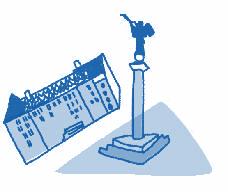
Įdomybė: nedaug kas žino, kad Užupio gatvė toje vietoje, kur stovi Angelo skulptūra, kažkada buvo vadinama Mirties gatve. Nesaugus rajonas sparčiai keitėsi, kai čia ėmė keltis menininkai ir studentai, kuriems nerūpėjo gyvenimas be vandentiekio ir panašūs patogumai.
6. Meno inkubatorius. Užupis yra toks ryškus ir įdomus dėl čia gyvenančių ir kuriančių menininkų, todėl užsukti į meno inkubatorių būtina. Nuo Angelo skulptūros
eikite Užupio tilto link ir prieš jį sukite į dešinę, lįskite toliau į spalvingus kiemus. Viename iš jų menininkai įkūrę Užupio dailės galeriją pavadinimu „Galera“. Joje vyksta ne tik meno parodos – čia įrengtos ir menininkų dirbtuvės, jie čia gyvena ir organizuoja šventes. Galerijos pavadinimas pasirinktas ne veltui: šalia sraunios upės esantis pastatasištiesųprimenagalerą–priešsrovę plaukiantį laivą. Akimis susiraskite ir pamojuokite Undinėlei, sėdinčiai šalia tilto –dar vienai Užupio grožybei.

Visas Užupio gyvenimas ir senovėje, ir dabar smarkiai susijęs su upe, vandeniu. Anksčiau čia buvusių priemiesčių – Paplaujos ir Tymo – išskirtinumas – „nedaug gatvių, bet daug vandens“. Čia kadaise veikė daug malūnų, fabrikų, todėl dar XV a. buvo nutiestos trys svarbiausios vandens kanalų atšakos, o žemame kairiajame upės krante sukurta ištisa kanalų, užtvankų, tiltų, salų ir salelių sistema. Ji egzistavo iki pat XIX a. pabaigos.
Kažkadačiabuvodaugtiltų,jungiančiųUžupįsumiestu,daugelisdabarjaunugriauta, išliko tik keli, jie labai mėgstami vestuvininkų (atkreipkite dėmesį į „amžinos meilės“ simbolius – spyneles, kuriomis nukabinėti visi Užupio tiltai). Vienas toks gražus tiltelis yra visai šalia Tibeto skvero, kuris atsirado Užupio menininkų iniciatyva.
7. Užupio respublika ir jos konstitucija. Grįžkite prie Angelo skulptūros ir sukite į dešinę – Paupio gatvę. Čia rasite Konstitucijos sieną –vieną lankomiausių Užupio objektų. Ant veidrodinių lentų išraišytas 41 nepriklausomos Užupio respublikoskonstitucijosįstatymasįvairiomispasaulio kalbomis. Įdomu, ar jų laikosi užupiečiai?
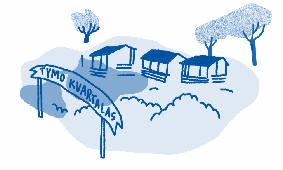

8. Tymo kvartalas kadaise buvo vargingas ir nykus – aplinkui susigrūdę maži, nevienodo aukščio nameliai su aplūžusiais mediniais priestatais. Į kvartalą pateksite eidami iš Aukštaičių gatvės, per Kūdrų parką. Tymo priemiestyje XV a. atsirado pirmosios Vilniuje tymo (išdirbtos ožio odos) amatų dirbtuvėlės, nes odos meistrai dėl savo darbo specifikos (rūgstančios odos smarvė – menkas malonumas) ir gaisrų pavojaus dažnai buvo iškeldinami į užmiesčius. Kiek vėliau čia apsigyveno totoriai, kurie taip pat vertėsi tradiciniu amatu – odų apdirbimu. XIX a. viduryje daugelis šio kvartalo namų priklausė smulkiems žydų prekeiviams. Namų pirmuose aukštuose veikė karčemos, kepyklos,
parduotuvės.Tymokvartalasneapsiėjoirbekriminalų–vietosgyventojaiypačkentėjo nuo vagysčių, plėšikavimų, girtuoklių siautėjimo. Šiuo metu Tymo kvartale vyksta
ūkininkų ir maisto turgeliai, čia mėgstama miestiečių pasivaikščiojimų vieta. Žiemą Kūdrų parke įrengiama čiuožykla, kur vyksta nemokamos čiuožimo pamokos.

9. Vilniaus Bastėjos požemiai. IšAukštaičių gatvės kopkite į kalną O. Šimaitės gatve, sukite kairiau ir Bokšto gatve eikite Bastėjos (Barbakano) link. Tai gynybinis įtvirtintas žemių ir mūro statinys tarp Subačiaus gatvės ir Vilnios upės. Jis buvo pastatytas XVII a. pirmojoje pusėje prie gynybinės
sienos, Bokšto kalne. Vėliau radosi daugybė legendų, susijusių su bastėjos požemiais. Viena iš legendų pasakoja, kad kalno požemiuose gyveno mitinė pabaisa – slibinas baziliskas, užmušdavęs prisiartinusį žmogų vien savo baisiu žvilgsniu. Tačiau kartą vienas jaunuolis įėjo į požemį nešinas dideliu veidrodžiu. Baziliskas puolė jaunuolį, bet šis pasislėpė už veidrodžio. Siaubūnas, išvydęs savo atvaizdą veidrodyje, griuvo negyvas. Šiuo metu čia veikia muziejus, jame galima apžiūrėti visokių ginklų: akmeninių patrankų sviedinių, senųjų patrankų, raitelių apsauginių šarvų bei daug kitų Vilniaus istorijos įdomybių.
10. Subačiaus gatvės apžvalgos aikštelė. Užupio tyrinėjimą pabaigsime apžvalgos aikštelėje, Subačiaus gatvėje. Į ją pateksite eidami Bokšto gatve aukštyn. Iš čia atsiveria viena gražiausių Vilniaus panoramų! Apžvalgos vietoje įrengta informacinė lenta parodo, kokie senamiesčio kultūros, istorijos, architektūros objektai yra matomi. Netoliese veikia kavinė, iš čia vasarą smagu stebėti Vilniaus bokštus.
11. Aušros vartai. Nuo Subačiaus
apžvalgos aikštelės M. Daukšos gatve eikite iki Aušros vartų – vienintelių miesto vartų, išlikusių iki mūsų dienų. Beje, iki šiol nėra tiksliai žinoma, kodėl vartai taip pavadinti. Aušros vartų gatvėje yra net trijų skirtingų religijų bažnyčios: unitų, stačiatikių ir katalikų. Įėję pro vartus į senamiestį, atsisukite–viršjųpamatysiteiškilusiąkoplyčią–taibenegarsiausiasVilniauspaveikslas –GailestingosiosDievomotinosatvaizdas,kurįgerbiavisųminėtųreligijųatstovai. Šie vartai išliko tik dėl koplyčios ir joje esančio garsiojo paveikslo – visi kiti vartai ir didžioji sienos dalis buvo nugriauti apie 1800 m., nes, kaip sakė to meto valdžia, „trukdė miestui vėdintis“!
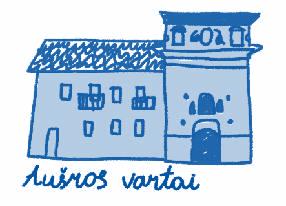

Kalnų Park and Bekešas Hill → Užupis → The Bernardine Cemetery → The courtyards of Užupis → The Bronze Angel of Užupis → Užupis Art Incubator → The Republic of Užupis and its Constitution → Tymo Quarter → The vaults of Vilnius Bastion → The Subačiaus Street Panoramic Pitch → The Gate of Dawn

1. Kalnų Park and Bekešas Hill. Start your adventure on the highest part of the city, in Kalnų Park. The first challenge is to find Bekešas Hill. Bekešas Hill is the favorite meeting place of the heroes of this comic book who study at Vilnius Užupis Gymnasium. Every Friday they meet here to explore the city. Firstly, start walking on Antakalnio Street, go through Kalnų Park towards Vilnelė river until you reach a smallbridgeleadingtothegatesofEmbassyoftheNetherlands.Fromhereturntothe rightandwalktowardstheobeliskofacommanderKasparasBekešas.Ifyouclimbthe hillfromUžupisStreet,youwillspotthetrailbehindUžupisGymnasium.Onceupon a time a brick tower (or a monument) dedicated to the brave general of a Hungarian descent Kasparas Bekešas was standing on this hill. Since he wasn’t a Catholic, he was laid to rest on the bank of the river. Words were engraved on the monument of this braveman:“Ilongfornoheaven,Ifearnohell.”Sadlyinthe19thcentury,theoriginal monument together with the grave of Bekešas tumbled down into Vilnelė river. Only the obelisk made of oak remained, pointing towards the hill. By the way, Vilnelė river was once known for its swiftness. It used to wash away sandy banks causing the collapse of the nearby hills.
2. Užupis. WearegoingtoexploreUžupis,oneoftheoldestVilniusneighborhoods, mentioned as early as the 15th century. Užupis is situated east of the Old Town, on therightbankof Vilnelėriver.Manybridgesconnecttheneighborhoodtothecity.In the old times Užupis with many windmills built along the swift river was the suburb of the poor. Craftsmen (especially weavers) and small-time clerks lived here. Until the end of the 20th century, it was an abandoned and dangerous part of the city, in which residents were afraid to set foot. But later Užupis became more and more popular among the artists. They started buying cheap apartments without the basic amenities and enjoy the bohemian style of life. Soon the artists established a community. Finally,theydaredtodeclareUžupisanindependentrepublicwithitsownconstitution, president, anthem, festivals, two churches, a bishop, high school, and a cemetery. The monument of the guardian of the republic, the Bronze Angel of Užupis, was erected in the main square. Nowadays Užupis is a prestigious and one of the most expensive neighborhoods in Vilnius. However it has kept its bohemian atmosphere and colorful presence.
3. The Bernardine Cemetery. Go to the Bernardine Cemetery through White Alleyway (Baltasis skersgatvis). The Bernardine Cemetery was established by the Bernardine monks in 1810. Many famous people of science, art, and culture, as well as the participants of uprisings are buried here. For example, one of the most famous photographers of old Vilnius, Juozapas Čechavičius, rests here. However, this graveyard is no ordinary! If you want to feel the old spirit of Vilnius, its serene, peaceful and mysterious atmosphere, you have to come here and take a walk. You would see not only impressive tombstones (read theirinscriptionswithcare!)butalsostrangebuildingscalledcolumbariums,withthe graves walled up in their niches. In the 19th century, the cemetery which reminded of aparkbecameafavoriteplaceforwalks.Youtootakeastrollaroundthecemeteryand noticethenumberofangelsculptures!Ifyouhappentocomehereinspringwhenthe blue scillas burst into bloom, you would experience something beautiful and strange at the same time. A point of interest: There is a private house on the territory of the cemetery, where mysterious people have been living to this day. Don’t forget to say hello to them!


4. The Courtyards of Užupis. Do you want to experience the unique aura of Užupis? If so, bravely venture into still open courtyards and squares of this neighborhood! Old courtyards of Užupis look as if they have been preserved by time: open wooden staircases, linens, fluttering in the wind, verdant gardens and flowerbeds of blossoming rues in summer, old water columns and wooden pantries-woodsheds. Hereyoucouldstillseethepreservedstonepavingcalled brukas. Modern buildings having been built at a more rapid pace strangely fit with the old buildings.ComingdownonPolockoStreetandthenUžupioStreet,divearoundopen courtyards. In one of them you will find the St. Bartholomew’s Church, the smallest church in Vilnius! A stunning view of Vilnius opens up from the church’s courtyard.
5. The Bronze Angel of Užupis is a brass and bronzemonumentinthecentralsquareofUžupis built by the artists in the memory of a very loved artist of the neighborhood, Zenonas Šteinys. Sculptor Romas Vilčiauskas and architect Algirdas Umbrasas created the Angel. Long time ago before WWI, in the place of the sculpture a brick chapel and a water column stood. The same column still stands here today, only a bit farther, in the corner. Interestingfact:NotmanypeopleknowthatUžupioStreetwherenowstandstheAngel was once called the Street of Death. Once unsafe neighborhood had experienced

a rapid change, when artists and students who didn’t mind living without water and other basic amenities started moving here.

6. Užupis Art Incubator. Užupis Art Incubator is a must-see. The neighborhood is so vivid and interesting because of the artists who live and create here. From the Bronze Angel walk towards the Bridge of Užupis. Before you reach it, turn to the right and go further down. Explorethecolorfulcourtyards.Inoneofthem artists established the Art Gallery of Užupis, called “Galera.” The place houses not only art exhibitions. Art studios are also set up here. This is where Užupis artists live and organize various art events. The name for the gallery wasn’t chosen accidentally: The building itself, situated alongside the swift river, indeed reminds of a galley – a ship sailing upstream. Look around and spot the Little Mermaid sitting by the bridge, another beautiful object of Užupis. Wave to her!
Once there were a lot of bridges that connected Užupis to the city. Although the majorityhavebeendemolished,afewofthemstillexist.Theyareverypopularamongthe newlyweds (notice the symbols of a “forever lasting love,” i. e. small locks attached to the handrails of the bridges). One such a beautiful bridge is near the Square of Tibet. The square was also opened by the initiative of Užupis artists.
7. The Republic of Užupis and its Constitution. Go back to the Bronze Angel and turn to the right on Paupio Street. Here you will see the Constitution mounted on the wall, one of the most visited objects in Užupis. 41 articles of the independent Republic of Užupis Constitution are engraved onto the wall-mounted mirror in different world languages. I wonder, if the citizens of Užupis comply with them?

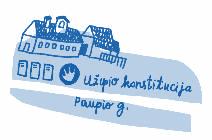
8. Tymo Quarter was once a grim and poverty stricken place. Small houses of various height with ramshackle wooden outbuildingswerecrampedtogether.These days you can get there from Aukštaičių Street, by walking through the Park of Ponds (Kūdrų parkas). In the 15th century Vilnius,thefirstsmallworkshopsofleather(lambskininparticular)craftswereestablished in Tymo Quarter. Leather craftsmen were ousted to the suburbs for the specifics of their craft (the stench of soaking leather was hard to bear) and for the danger of possible fires. Later Tatars moved in. They also engaged in their traditional craft, the tanning of the leather. In the middle of the 19th century, most of the houses on
the block belonged to Jewish merchants. Taverns, bakeries and stores operated on the first floors of the houses. There was also crime in Tymo Quarter and local residents especially suffered from thefts, looting and the rampaging of alcoholics. Nowadays the Quarter is known for its farmers’ and food market. Townsfolk like to come here for a walk. In winter, a skating rink is constructed in the Park of Ponds, where you can take skating classes for free.

9. The vaults of Vilnius Bastion. From Aukštaičių Street climb up the hill on O. Šimaitės Street, then turn slightly to the left and walk towards the Bastion („barbican“).Thefortificationmadeofsoilandbrick is located between Subačiaus Street and the Vilnelė. It was built in the first half of the 17th century on the Tower Hill, along the Vilnius Defensive Wall. Later many legends about the cellars of the Bastion originated. One of the legends is about a mythical monster – the basilisk or dragon that lived inthevaultsofthehillandwouldkillanyhumanwhocamenearitonlybyitsfrightful glare.Onceayoungmanenteredthecellarwiththebigmirrorinhishands.Whenthe basilisk attacked the man, he hid behind the mirror. Once the monster saw its own reflection in the mirror, it dropped dead. Nowadays a museum operates here, where you can see various guns, such as stone cannon balls, ancient cannons, shield armors and many other interesting objects from Vilnius history.
10. The Subačiaus Street Panoramic Pitch. We will finish exploring Užupis on the Subačiaus Street panoramic pitch. We will get there by walking upwards on Bokšto Street. One of the most beautiful views of Vilnius opens from here! On the site,thereisaninformationboardwhichshowsyouwhatOldTown’scultural,historic and architectural objects you can spot. There is also a café nearby. It so fun to look at the towers of Vilnius in summer.

11. The Gate of Dawn. From the Subačiaus site walk further on Mikalojaus Daukšos Street until you reach the Gate of Dawn, the only city gate remaining to this day. By the way, no one knows why it has such a name. Three churches belonging to three different religions: the Byzantine Rite Eastern Catholic Church, the Orthodox Church andtheCatholicChurch,arelocatedonAušrosVartųStreet.Onceyouwalkthrough the Gate to the Old Town turn around and you will see the protuberant chapel with perhaps the most famous icon in Vilnius – the portrait of The Blessed Virgin Mary, Mother of Mercy worshiped by the representatives of all the previously mentioned religions.Thegateremainedintactonlybecauseofthechapelandthefamousicon.All other gates and the majority of the wall were demolished in 1800, because, according to the local authority, “they prevented the city from ventilating“!
PROJEKTĄ ĮGYVENDINO

Vilniaus miesto savivaldybės administracijos
Užsienio ryšių ir turizmo skyrius
www.vilnius.lt
KOMIKSO SCENARIJŲ IR TEKSTUS KŪRĖ „AUKSO ŽUVYS“
Komiksą piešė Akvilė Magicdust
Redagavo Inga Migūnaitė-Kmitienė Maketavo Zigmantas Butautis
Į anglų kalbą vertė Ieva Matusevičiūtė
Vertimo redaktorė Dalia Cidzikaitė
© Akvilė Magicdust, 2017
© Aukso žuvys, 2017
© Vilniaus savivaldybė, 2017
ISBN 978-609-8120-33-2

